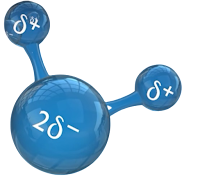Microwaves work almost like magic. They cook food without external heat and with good regularity compared to traditional methods. Despite its benefits, however, some are nervous about the health hazards of electromagnetic waves. Can microwaves cause harm? Let's find the answers to the questions in this article.
 |
| Magnetron |
 |
| Polar molecule of water |
The best way to make
this reflector is with the help of metal. The metal surface causes microwaves
to reflect off its surface, and if you hold another reflector on the source
side, the reflection will continue. In this way, one can capture the energy of
electromagnetic radiation within a chamber However, the most efficient way to
capture the energy of electromagnetic waves is to use a technique called a
resonant cavity. In this way, the intensity of electromagnetic waves also increases.
Let's understand the concept of the resonant cavity using a simplified standing wave approach. A standing wave is a standing wave that varies in time but does not propagate in space. You can understand how a standing wave differs from a normal traveling wave. It occurs when two waves of equal amplitude and frequency, propagating in opposite directions, are superimposed on each other. You can understand that the waves have phase differences of 180. If you add both electromagnetic waves here, they cancel each other out perfectly.
 |
| Standing wave |
Let's explore a
practical way to create two opposing traveling waves. We will get a clear
solution to this when we understand how electromagnetic waves are reflected
from a metal surface. We know that when a wave hits a reflector, it returns to
its source. Can you find a correlation between this reflected wave and the
incident wave? The reflected wave is actually the wave that would have traveled
forward if reflectors are not placed.
 |
| Incident and second reflected wave |
This is a clever
solution. Placing the second reflector this way we only see two waves traveling
in opposite directions instead of lots of reflected waves. If you
find out the result of this, it will be a standing wave. It is known that
standing waves arise when the distance between the source and the reflector is
an integral multiple of half the wavelength.
Therefore, the
dimensions of the closed structure are determined by the wavelength of these
waves. A fun fact now is to measure the cavity length of the microwave oven in
your kitchen. It will be an integer multiple of that wavelength.
 |
| Cheese with hot and cold spots |
Another query that
needs to be responded to is whether or not microwaves are the most effective
electromagnetic waves able to heat food or if there are other methods that
might accomplish the identical result. The solution is that any electromagnetic
waves have the ability to warm however they arrive with definite limitations. Waves with large wavelengths can without difficulty pass through the food in order that they may not be capable of producing plenty strength to
it additionally. To get a standing wave, larger devices may be required. Shorter
wavelength waves are absorbed extra swiftly at the outer floor of the food. So
they do not penetrate far enough inside the food to cook it even if we want to cook deeply. So we have to apply high power that might be unfeasible
withinside the microwave range. The appropriate frequency for all realistic
functions and which did now no longer require a license become 2.45 GHz. The effective microwaves produced with the aid of using an oven may
be dangerous to human beings if we are available in direct touch with them. But
do not worry the electromagnetic radiation produced with the aid of using a
microwave oven is usually constrained inside it. It will by no means go away
from the chamber so there's no factor in disturbing approximately the fitness
dangers because of the electromagnetic radiation of microwave ovens.
Now the most query is why heating with a microwave oven is superior to traditional heating strategies. Since microwaves can penetrate that food. The meals are cooked from the inside slowly than cooking on the outer side. Moreover, it cooks food quicker than different traditional strategies. The traditional method cooks food from the outside in as opposed to the inside out. This is because the heat energy has to travel from outside to inside but this method can be useful on some occasions when you need food with a crisp surface and a soft interior or baking the traditional heating method is preferred. Due to this reason, modern microwave ovens come with a traditional option for cooking purposes. We hope you got a complete understanding of the physics behind microwave ovens.
Please don't forget to be a part of our team so comment before you leave. Thank you.



0 Comments